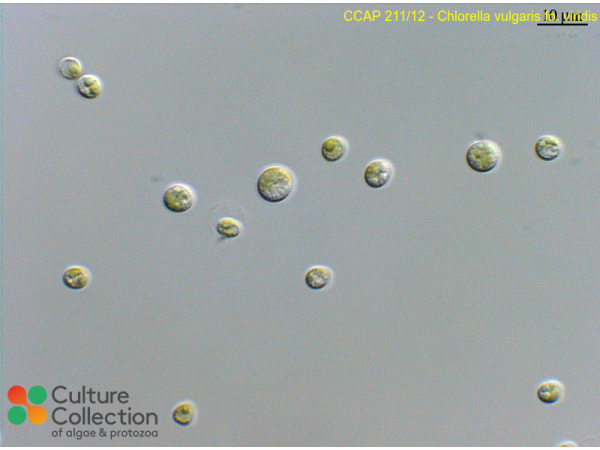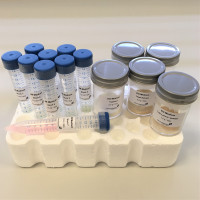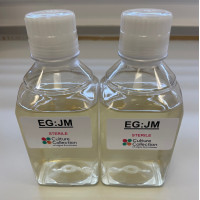References [ 29 ]
Müller J, Friedl T, Hepperle D, Lorenz M & Day JG (2005) Distinction between multiple isolates of Chlorella vulgaris (Chlorophyta, Trebouxiophyceae) and testing for conspecificity using Amplified Fragment Length Polymorphism and its rDNA sequences. Journal of Phycology 41(6): 1236-1247.
Day JG, Benson EE & Fleck RA (1999) In Vitro Culture and Conservation Of Microalgae: Applications For Environmental Research, Aquaculture & Biotechnology. In Vitro Cellular & Developmental Biology - Plant 35: 127-136.
Nguyen-Ngoc H, Durrieu C & Tran-Minh C (2009) Synchronous-scan fluorescence of algal cells for toxicity assessment of heavy metals and herbicides. Ecotoxicology and Environmental Safety 72: 316-320.
Nguyen-Ngoc H & Tran-Minh C (2007) Fluorescent biosensor using whole cells in an inorganic translucent matrix. Analytica Chimica Acta 583: 161-165.
Crossman ZM, Ineson P & Evershed RP (2005) The use of 13C labelling of bacterial lipids in the characterisation of ambient methane-oxidising bacteria in soils. Organic Geochemistry 36: 769-778.
Hammill E & Beckerman AP (2010) Reciprocity in predator-prey interactions: Exposure to defended prey and predation risk affects intermediate predator life history and morphology. Oecologia 163: 193-202.
Beckerman AP, Wieski K & Baird DJ (2007) Behavioural versus physiological mediation of life history under predation risk. Oecologia 152: 335-343.
Hammill E, Rogers A & Beckerman AP (2008) Costs, benefits and the evolution of inducible defences: A case study with Daphnia pulex. Journal of Evolutionary Biology 21: 705-715.
Puértolas L, Damásio J, Barata C, Soares AMVM & Prat N (2010) Evaluation of side-effects of glyphosate mediated control of giant reed (Arundo donax) on the structure and function of a nearby Mediterranean river ecosystem. Environmental Research 110: 556-564.
Isik O, Sarihan E, Kusvuran E, Gül Ö & Erbatur O (1999) Comparison of the fatty acid composition of the freshwater fish larvae Tilapia zillii, the rotifer Brachionus calyciflorus, and the microalgae Scenedesmus abundans, Monoraphidium minitum and Chlorella vulgaris in the algae-rotifer-fish larvae food chains. Aquaculture 174: 299-311.
DOI: none
Natrah FMI, Kenmegne MM, Wiyoto W, Sorgeloos P, Bossier P & Defoirdt T (2011) Effects of micro-algae commonly used in aquaculture on acyl-homoserine lactone quorum sensing. Aquaculture 317: 53-57.
Martin D & Ridge I (1999) The relative sensitivity of algae to decomposing barley straw. Journal of Applied Phycology 11: 285-291.
Schluter L, Lauridsen TL, Krogh G & Jorgensen T (2006) Identification and quantification of phytoplankton groups in lakes using new pigment rations - a comparison between pigment analysis by HPLC and microscopy. Freshwater Biology 51: 1474-1485.
Fawley MW & Fawley KP (2004) A simple and rapid technique for the isolation of DNA from microalgae. Journal of Phycology 40: 223-225.
Nowack ECM, Podola B & Melkonian M (2005) The 96-well twin-layer system: A novel approach in the cultivation of microalgae. Protist 156: 239-251.
Maury-Ramirez A, De Muynck W, Stevens R, Demeestere K & De Belie N (2013) Titanium dioxide based strategies to prevent algal fouling on cementitious materials. Cement & Concrete Composites 36: 93-100.
Manso S, De Muynck W, Segura I, Aguado A, Steppe K, Boon N & De Belie N (2014) Bioreceptivity evaluation of cementitious materials designed to stimulate biological growth. Science of the Total Environment 481: 232-241.
De Muynck W, Maury Ramirez A, De Belie N & Verstraete W (2009) Evaluation of strategies to prevent algal fouling on white architectural and cellular concrete. International Biodeterioration & Biodegradation 63: 679-689.
De Castro-Catala N, Munoz I, Armendariz L, Campos B, Barcelo D, Lopez-Doval J, Perez S, Petrovic M, Pico Y & Riera JL (2014) Invertebrate community responses to emerging water pollutants in Iberian river basins. Science of the Total Environment 503-504: 142-150.
Mackay S, Gomes E, Holliger C, Bauer R & Schwitzguébel J (2015) Harvesting of Chlorella sorokiniana by co-culture with the filamentous fungus Isaria fumosorosea: A potential sustainable feedstock for hydrothermal gasification. Bioresource Technology 185: 353-361.
Eyssautier-Chuine S, Vaillant-Gaveau N, Gommeaux M, Thomachot-Schneider C, Pleck J & Fronteau G (2015) Efficacy of different chemical mixtures against green algal growth on limestone: A case study with Chlorella vulgaris. International Biodeterioration & Biodegradation 103: 59-68.
López Barreiro D, Bauer M, Hornung U, Posten C, Kruse A & Prins W (2015) Cultivation of microalgae with recovered nutrients after hydrothermal liquefaction. Algal Research 9: 99-106.
Guo MZ, Maury-Ramirez A & Poon CS (2015) Versatile photocatalytic functions of self-compacting architectural glass mortars and their inter-relationship. Materials and Design 88: 1260-1268.
Beddow J, Johnson RJ, Lawson T, Breckels MN, Webster RJ, Smith BE, Rowland SJ & Whitby C (2016) The effect of oil sands process-affected water and model naphthenic acids on photosynthesis and growth in Emiliania huxleyi and Chlorella vulgaris. Chemosphere 145: 416-423.
Escapa C, Coimbra RN, Paniagua S, García AI & Otero M (2016) Comparative assessment of diclofenac removal from water by different microalgae strains. Algal Research 18: 127-134.
Rugnini L, Costa G, Congrestri R & Bruno L (2017) Testing of two different strains of green microalgae for Cu and Ni removal from aqueous media. Science of the Total Environment 601-602: 959-967.
Upadhyay LSB, Kumar N & Chauhan S (2018) Minireview: Whole-cell, nucleotide, and enzyme inhibition-based biosensors for the determination of arsenic. Analytical Letters 51: 1265-1279.
Eyssautier-Chuine S, Calandra I, Vaillant-Gaveau N, Fronteau G, Thomachot-Schneider C, Hubert J, Pleck J & Gommeaux M (2018) A new preventive coating for building stones mixing a water repellent and an eco-friendly biocide Progress in Organic Coatings 120: 132-142.
Jian J, Torres-Montero P, Bai M, Lu Y & Simonsen HT (2024) Genome analysis of Chlorella vulgaris (CCAP 211/12) mutants provided insight into the molecular basis of chlorophyll deficiency Algal Research 78: 103426.





